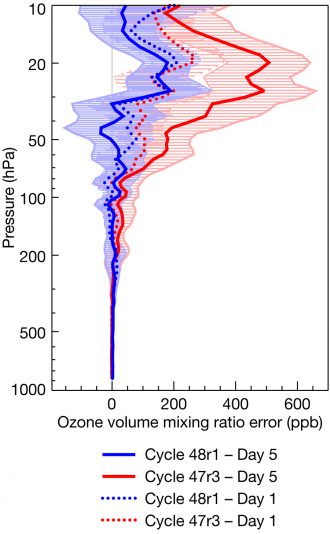The operational forecasting system for global atmospheric composition of the EU’s Copernicus Atmosphere Monitoring Service (CAMS), implemented by ECMWF, has been substantially extended with the upgrade to Cycle 48r1 of the Integrated Forecasting System (IFS) on 27 June 2023.
The most important innovations are:
- the simulation of stratospheric chemistry with the BASCOE scheme
- the addition of secondary organic aerosols and new tropospheric species
- improved treatment of sectorial emissions
- assimilation of carbon monoxide retrievals from the Sentinel‑5P satellite.
Stratospheric chemistry in the IFS
IFS components concerning atmospheric composition (IFS-COMPO), which are activated in global CAMS forecasts with the IFS, are developed in collaboration with European research institutes and national weather services. Several schemes for both tropospheric and stratospheric chemistry are implemented in the IFS. They include the Belgian Assimilation System for Chemical ObsErvations (BASCOE) and the Carbon Bond Mechanism 5 (CB05).
The development of stratospheric BASCOE chemistry in the IFS had reached sufficient maturity to be applied operationally in Cycle 48r1, in combination with the tropospheric CB05 scheme. Important steps were updates to the photolysis calculation in BASCOE and the introduction of the advection of chemical families to mitigate long-term trends caused by the lack of mass-conservation in the IFS. Prior to Cycle 48r1, linear parametrizations of stratospheric ozone chemistry, which are still applied in IFS numerical weather prediction (NWP) applications, were used in the operational CAMS forecast in combination with the CB05 scheme.
The CB05-BASCOE scheme makes it possible to fully represent chemistry throughout the atmosphere in the IFS in the operational CAMS forecast of Cycle 48r1 as well as in the upcoming production of a new version of the CAMS reanalysis of atmospheric composition. This means that CAMS will be able to forecast and monitor chemical species that control the formation of the ozone hole caused by long-lived ozone depleting substances, such as chlorofluorocarbons (CFCs) and hydrochlorofluorocarbons (HCFCs) and their short-lived products that cause the actual ozone destruction (see the figure). Processes such as the production of stratospheric water vapor by oxidation of methane, which is approximated by a parametrization in NWP applications of the IFS, can also be accounted for more realistically. Finally, the introduction of stratospheric chemistry in the IFS opens new opportunities for the data assimilation of satellite observations of stratospheric trace gases, such as bromine monoxide (BrO), chlorine monoxide (ClO) or nitrogen dioxide (NO2).

Secondary organic aerosols and new tropospheric species
Secondary organic aerosols (SOA) are a substantial fraction of observed particulate matter concentrations. Up to Cycle 47r3, SOAs were not simulated in the IFS, and simplified assumptions were made to treat them as part of primary organic matter aerosol. With Cycle 48r1, two SOA species, originating from anthropogenic or biogenic condensable organic precursor gases, were introduced in the AER aerosol scheme of IFS-COMPO. While this approach is still simple considering the complexity of SOA formation, it is an important first step to better represent SOAs and to account for transport during the time it takes to convert gaseous precursor emissions into SOA.
The tropospheric chemistry scheme based on CB05 in Cycle 48r1 has been extended to include the chemical species glyoxal and hydrogen cyanide (HCN). Tropospheric glyoxal concentrations can be retrieved from satellite instruments such as TROPOMI on Sentinel-5P and the CAMS forecast can provide glyoxal data as prior information to these retrievals. HCN is an important tracer of biomass burning and can also be observed from space. Increased concentrations of HCN can contaminate infrared (IR) radiances from satellite instruments, and operational HCN forecasts may contribute to the quality control of assimilated IR radiances in NWP applications.
Improved representation of emissions
The emission processing for the CAMS global forecasting system has recently undergone a major restructuring. As a consequence, emissions for individual emission sectors, and not just the total emission, can be ingested in the IFS to enable the sector-specific application of diurnal cycles and injection heights. For example, emissions from industry and power generation, which are released by chimneys, are now emitted in a specific height range above the surface, whereas emissions from transport are emitted at the surface following a predefined diurnal profile. This update has contributed to improved forecasts of surface concentration of air pollutants in Europe, China and North America. Cycle 48r1 also uses more recent versions of anthropogenic and biogenic CAMS-GLOB (ANT5.3, BIO-3.1) inventory datasets.
Emissions of desert dust, which are calculated online in the IFS based on turbulent wind fields and soil properties, as well as the removal of dust by deposition, have been greatly revised in Cycle 48r1. The dust burden in Cycle 48r1 is about twice as high as the one in Cycle 47r3, and more weight was given to the super-coarse dust bin, which is in better agreement with observations.
Assimilated observations
The activation of the assimilation of new satellite retrievals of atmospheric composition does not always follow the cycle upgrade timeline, but Cycle 48r1 brought the start of the assimilation of total carbon monoxide (CO) retrievals from the TROPOMI instrument in addition to the ongoing assimilation of CO retrievals from the IASI and MOPITT instruments. This update led to a better forecast of long-range transport from intensive wildfires in Canada in June 2023.
Impact and way forward
CAMS forecasts are verified using independent observations from a wide range of different networks by external partners, led by the Royal Netherlands Meteorological Institute (KNMI). The evaluation of the Cycle 48r1 experimental forecasting system concluded that most of the forecast parameters, in particular carbon monoxide, Aerosol Optical Depth, ozone and nitrogen dioxide showed improved forecast accuracy.
The IFS-COMPO updates for Cycle 48r1 also provide opportunities for the introduction of more refined modelling approaches and a wider range of applications of the forecast, in particular for stratospheric trace gases and aerosols. Finally, it should be mentioned that a comprehensive documentation of the atmospheric composition aspect in the IFS has been compiled for the first time. This has been published as part of the IFS documentation relating to Cycle 48r1 (https://www.ecmwf.int/en/publications/ifs-documentation).
